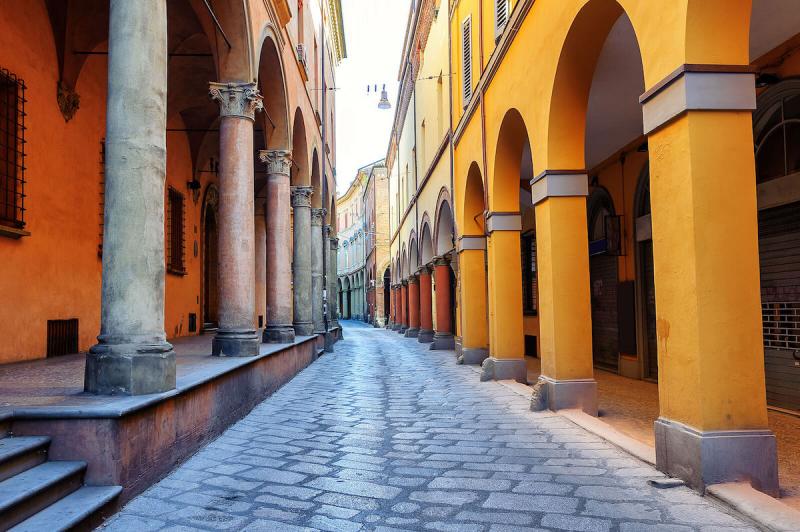A native Bolognese writer takes us on a tour of Bologna’s porticoes, recently inscribed by UNESCO onto its World Heritage list.
With its 62 kilometers of porticoes, of which 42 are in the historic center, Bologna is the most ‘arcaded’ city in Italy.
In July 2021, the porticoes of Bologna were inscribed onto UNESCO’s World Heritage list. As reported by UNESCO, “the porticoes have become an expression and element of Bologna’s urban identity.” Indeed, porticoes are not only an identifying architectural element of the city, they are also part of the collective identity of the Bolognesi, who stroll, shop and sit for coffee or aperitivo under them, and find shelter from inclement weather.
But why did porticoes have such an extensive development in Bologna, and not in other Italian cities, so much so that Bologna is known as la città dei portici?

The origins of Bologna’s porticoes can be traced back to the Middle Ages, in the years around 1100, when Bologna became an independent Comune and the University, the first in the Western world, was founded. These important developments began to attract new residents from the countryside, and students and professors from all over Europe. The need to create new residential and commercial spaces led the Bolognesi to find an ingenious solution: to create additional space starting from the first floor of the houses by extending the buildings outwards. The ledge that was created was supported by pillars, and a sequence of pillars created a portico.
If originally this was illegal construction, starting from 1288, a statute by the Comune of Bologna established that all new houses be built with a portico and that existing ones be equipped with one; it also mandated that porticoes, even though they were built by individuals on private land, remain for public use. Why? Because porticoes were useful for the community: they allowed people to walk protected from rain or excessive heat; artisans could work outside rather than being confined to the dark and humid environments of the ground floors, and display their products for the public to see; houses on the ground floor were saved from dirt and sewage from the streets; and students without accommodation could spend the night under the shelter of the porticoes.
The great development of porticoes occurred indeed with the arrival of students and professors at the University of Bologna, which caused an increase in the demand for new housing. Bologna’s Alma Mater, founded in 1088, was a pole of attraction for the scholars of the time.
The statute specified that porticoes had to be at least seven Bolognese feet high (2.66 meters) and equally wide, to allow the passage of a man on horseback. These measurements, especially in the poorest neighborhoods, were not always adhered to. From 1568, a papal decree ordered that wooden porticoes be replaced with stone or brick (to lessen the risk of fire). Again, not all complied.
The porticoes of Bologna as narrated by Italian actor Stefano Accorsi. (Click on CC for English subtitles.)
A tour of the porticoes of Bologna
Unless you want to undertake a real marathon under the 42 km of porticoes in the historic center of Bologna, here’s an itinerary I’ve designed to discover some of its most significant sections (I’m a native Bolognese). This itinerary will also allow you to see some of the most important monuments and places in the city.
Your portico tour should begin in Via Clavature, where you can observe the original structure that would evolve into the portico, the so-called ‘sporti,’ wooden beams placed diagonally. This can be seen at the Case Schiavina, which date back to the 13th century.
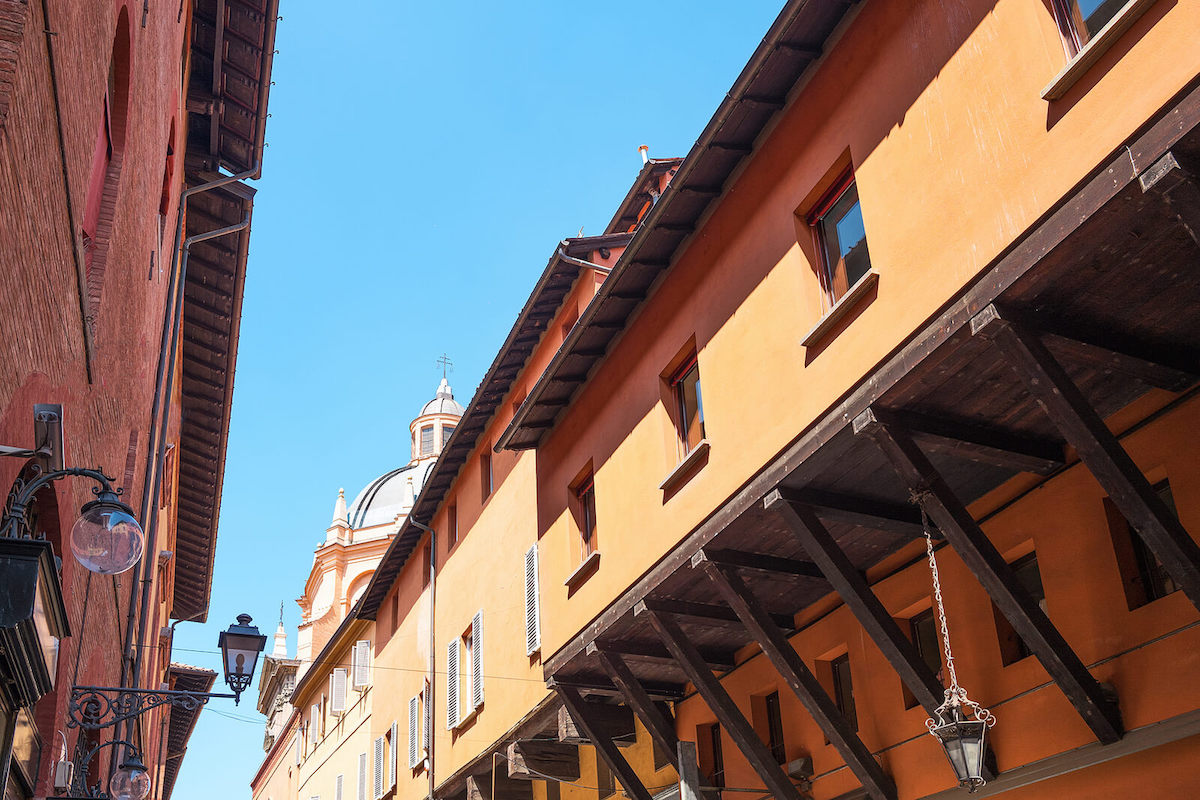
Via Clavature is in the area known as Quadrilatero, which houses the ancient city market, worth a stop to browse the historic food shops where you can taste and buy local delicacies, such as mortadella, fresh egg pasta and Parmigiano Reggiano.
Suggested stop: visit the Mercato di Mezzo, a recently restored covered market, where you can buy or consume typical local dishes on the spot. For meat lovers, try RoManzo, a butcher with restaurant.
From Via Clavature, walk to nearby Piazza Maggiore, Bologna’s main square, to reach the famous Portico del Pavaglione, a favorite of the Bolognesi, who love to stroll there on weekends and to window shop. Before walking through this 139-meter-long portico, visit Piazza Maggiore and the Bolognesi's most beloved church, the Basilica of San Petronio, one of the largest in Europe.
Suggested stop: go up to the second floor of Palazzo d'Accursio for an overall view of the square from the beautiful Sala Farnese.
Along the Portico del Pavaglione, so called for the ‘pavilion’ where the cocoon market was held (for silk production), is the entrance to what was the first unified seat of the University of Bologna, the Archiginnasio, built in the 16th century. Peek inside the internal courtyard, adorned with the numerous coats of arms of the students and professors who have attended the university over the centuries; on the first floor, visit the Anatomical Theater, made of fir wood, where the first anatomy lessons were held.
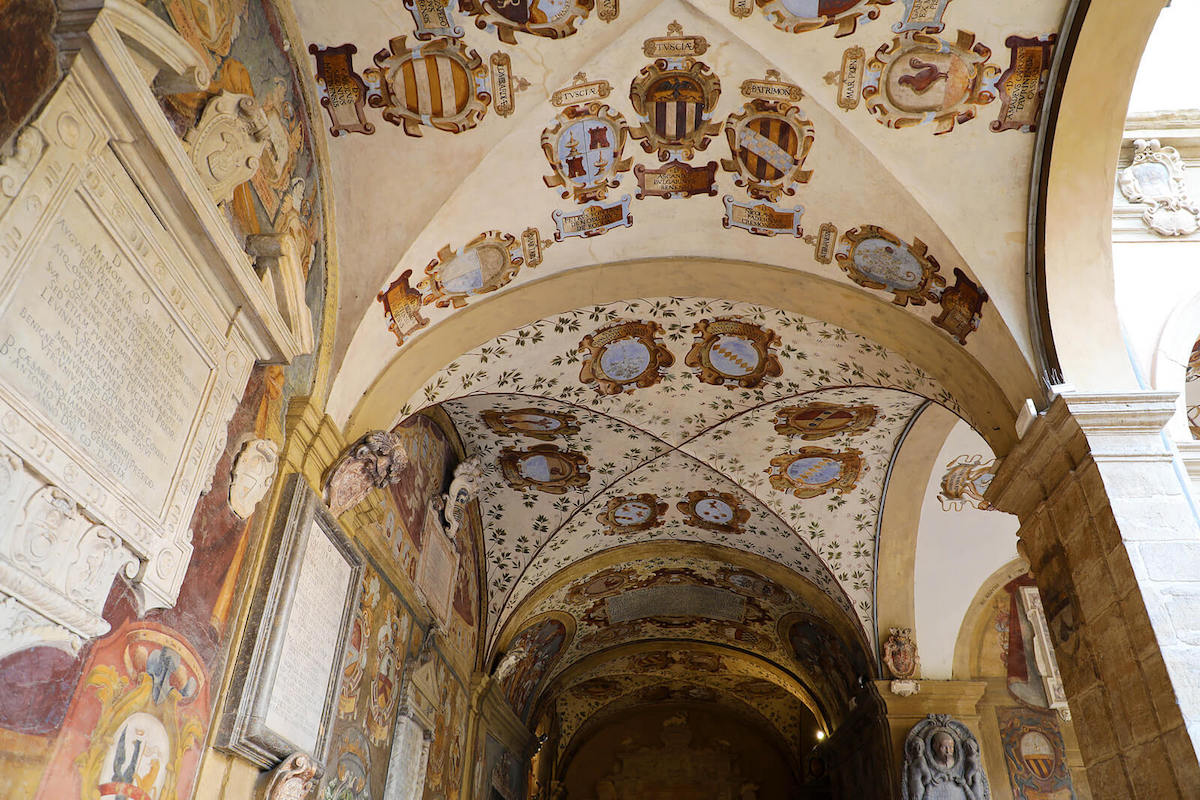
Suggested stop: at the corner between the Portico del Pavaglione and Via Farini is the historic Caffè Zanarini, where you can stop for coffee and a sweet treat; if the weather is good, it is very pleasant to sit at one of the outdoor tables in Piazza Galvani, behind the Basilica of San Petronio.
Continue to the left under the elegant porticoes of Via Farini (make a quick detour to nearby Piazza Cavour to admire the porticoes with frescoed ceilings); if you’re up for some luxury shopping enter Galleria Cavour, then continue to the point where Via Farini crosses the final part of Piazza Santo Stefano, one of the most beautiful squares in Bologna.
Enclosed by late medieval and Renaissance porticoes, Piazza Santo Stefano deserves a stop for a visit to the Basilica of Santo Stefano or Sette Chiese, as the Bolognesi call it, an ancient religious complex consisting of four churches and three chapels.
From the square take Corte Isolani, a covered passage that leads to Strada Maggiore, where there is a beautiful example of a medieval portico, Casa Isolani: dating back to the 13th century, it is supported by nine-meter-high stone and wooden columns. If you look at it from the other side of the street, you can see very well how the upper part of the building protrudes forward and is supported by the columns.
From Strada Maggiore you can reach the Two Towers, the Asinelli and the Garisenda, two medieval towers symbols of Bologna.
Suggested stop: climb the 498 steps up the Torre degli Asinelli to admire a beautiful view over the red roofs of Bologna and the surrounding hills. For quality crafts and souvenirs, Artigianarte, at the base of the Asinelli Tower, is a good option.
From the Due Torri, walk under the lively porticoes of Via Zamboni, the heart of the university district. Where once were noble and religious residences, today there are faculties and university offices.
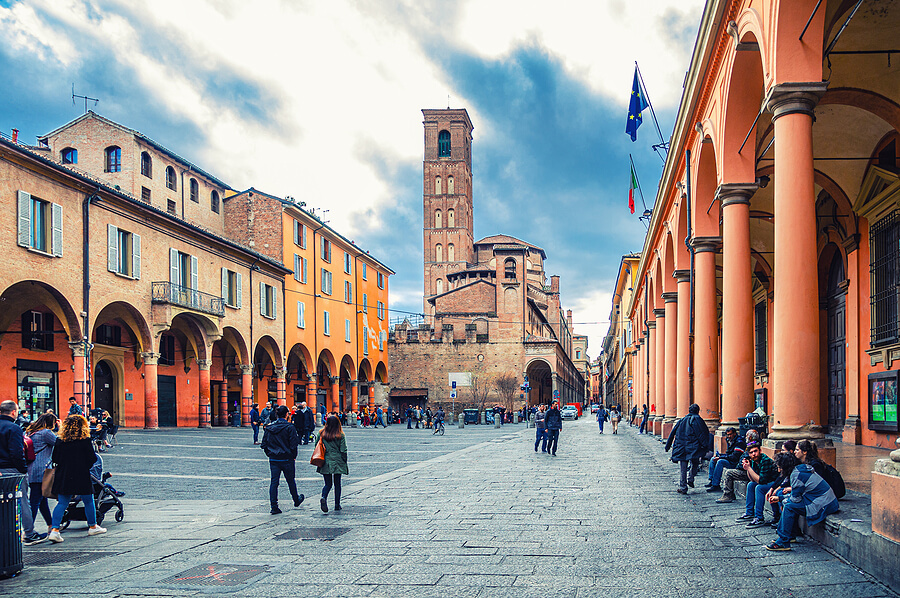
At Via Marsala, turn left until you reach the wooden porticoes of Palazzo Grassi and the opposite Boncompagni Houses. They are among the few remaining examples of porticoes supported by wooden beams with the typical ‘crutch’ shape.
Suggested stop: Marsalino, a local osteria, ideal for a quick lunch or an aperitivo.
Continue to the crowded porticoes of Via Indipendenza, one of Bologna’s main shopping streets. On weekends, Via Indipendenza is closed to traffic and the Bolognesi love to stroll up and down this fully porticoed street located between the train station and Piazza Maggiore.
An itinerary of the porticoes of Bologna would not be complete without a walk up the longest portico in the world, the Portico di San Luca, which measures almost four kilometers. Reachable on foot from the historic center, it begins at Porta Saragozza, just outside the ancient city walls, and leads you to another landmark Bologna monument, the Basilica of San Luca, which stands almost 300 meters high on the Colle della Guardia.
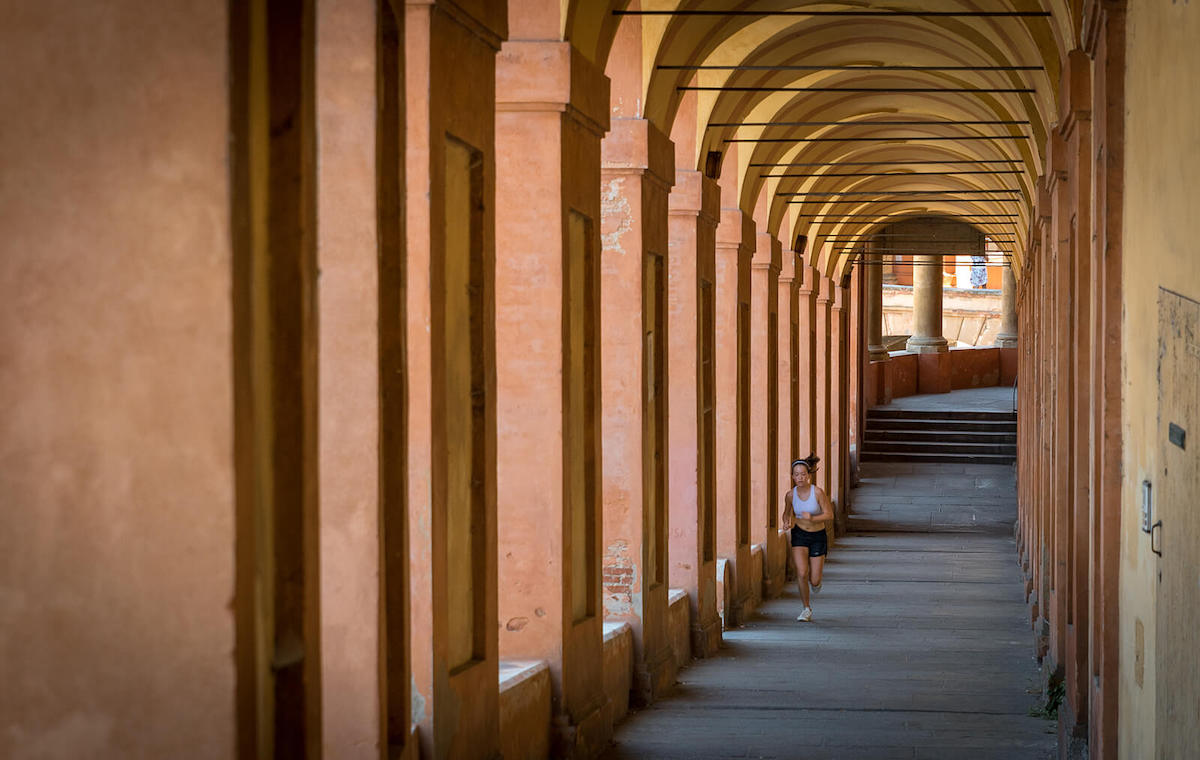
As you walk uphill, you will be accompanied by beautiful views of the city and of the hills, until you reach the Basilica, beloved by the Bolognesi who, when they see it up on the hill from the highway or the train coming back from a trip, know they are home again.
